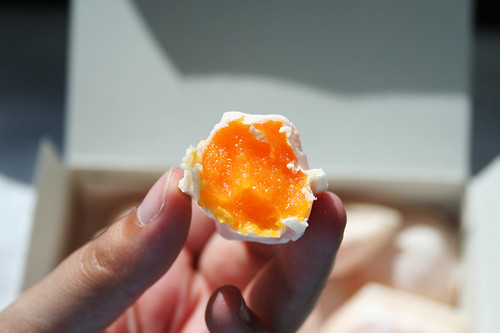The Portuguese sure like their food. Although a relatively small country, their cuisine is somewhat diversified and distinctive in each of the different regions. They value their meats, their seafood is some of the freshest in the world and their vegetables are cooked to perfection, but most of all ? the Portuguese love their desserts. You will never have your plate cleared in a Portuguese restaurant without being asked, ?What would you like for dessert??
For those of you that have visited Portugal, you will have probably noticed that every street has at least one pastelaria (pastry shop), usually occupied by a line of locals and tourists alike who have followed the sweet smells of fresh bread and toasted almonds. Dessert specialities include more than a whopping 200 different types of pastries. This national penchant for sweets seems to have originated during the Moorish occupation; in the 15th century, there was the sugar cane planted in Madeira. Then, sometime in the 17th and 18th centuries, Portuguese convents began to be known for their sweet pastries, including specialities such as ?toucinho do c?u? (heaven?s lard) and ?barriga de freiras? (nun?s belly). The convents would frequently compete to see which could produce the best sweets and desserts. There are even stories of the famous Bel?m pastries, whose recipe remains a closely guarded secret, or the ?Abade de Priscos Pudim?, dating back to a 14th century legacy from one of the best Portuguese cooks.
There are simply too many desserts to list them all, but if you have one week in Portugal, this is a list of the best seven Portuguese desserts ? one for each day of your stay:
The seven best Portuguese desserts

Toucinho do?C?u | Translating to ?Heaven?s Bacon?, this dessert was originally made with pork lard by convent nuns. These were women who understood the intrinsic ingredients of any good dessert: ridiculous amounts of sugar, a boat load of egg yellows and of course, more calories than you can imagine.
Differing from modern almond cakes, Heaven?s Bacon is extremely moist, rather than battery. You can find Toucinho do Ceu anywhere in Portugal, but for a more traditional (and delicious) version ? head north to the city of Guimaraes.

Aletria | You will be surprised to hear the main ingredient for this dessert ? a very thin kind of noodle (like vermicelli) that was brought into Portugal when the Moors settled. The Portuguese, sweet-toothed by nature, then turned these noodles into a sugary treat by boiling them in milk and adding butter, egg yolk, lemon zest and a sprinkle of cinnamon, creating something a little similar to rice pudding. A very traditional dessert, no Christmas table in Portugal is complete without a generous tray of Aletria.

Ovos Moles | Another dessert that centres on Portugal?s favourite ingredient combination: sugar and eggs galore. Ovos moles means ?soft eggs?, which pretty much sums up what this dessert is. Portuguese nuns once used egg whites to iron their garments and create this recipe accidently ? so as not to waste the remaining egg yellows. Ovos moles come in rolled cakes, inside traditional clay pots or, more famously, inside light wheat dough in the shape of items that symbolize Aveiro and its river.

Azevias de Mertola | Another dessert with origins inside religious institutions, Azevias de Mertola originates from the southern town of Mertola, where nuns devoted themselves to God and to making heavenly treats. The dessert is made up of fried dough pockets, filled with a smooth and creamy paste made of mashed chickpeas. Don?t worry, it tasted nothing like humous; Azevias are super sweet and extra delicious.

Bolinhos de Amendoa | Aside from sun, white sands and crystal waters, the Algarve is famous for the creative use of almonds.??Marzipan is taken to a whole new level by Algarvian sweet makers, filling the almond paste with an egg and sugar concoction known as ?fios de ovos? ? egg threads. Bolinhos de Amendoa is one of the most attractive sweets in the entire country, being most popularly presented in fruit shapes.

Pastel de Belem |These egg custard tarts are probably one of the most popular desserts amongst tourists. Originating from the area of Belem in Lisbon, Pastel de Belem is found all over Portugal, under the name Pastel de Nata. Pastel de Belem has been elected one of the ?7 Wonders of Portuguese Gastronomy? (yes this is a real thing!); people queue up in Belem to taste this cake where it was originally created, served warm straight out of the oven, with a burnt crust on top, a crumbly pastry base and a sprinkle of cinnamon on top. This take-away treat is the perfect companion to a cup of coffee or tea.

Bolo Rei (King Cake) | A traditional Portuguese cake that is typically made at Christmas and eaten up to Dia de Reis (the day of Kings). Its shape resembles a king?s crown. Made from soft, white dough, raisins, nuts and crystallized fruit, it is not so dissimilar from an English Christmas cake. When families bake this cake, they usually include a little prize within it and whoever slices the piece with the prize has to either bake or buy the next cake the following year.
You should read : Purple Hearts? Albufeira
Source: http://blog.purpletravel.co.uk/2012/08/27/sweet-tooth-in-portugal-a-guide-to-portuguese-desserts/
dodgers sale tami roman jetblue captain los angeles dodgers christie brinkley seattle mariners geraldo rivera
herniated disc sacramento kings luke scott tom benson royals nicole richie lyme disease symptoms
No comments:
Post a Comment
Note: Only a member of this blog may post a comment.